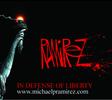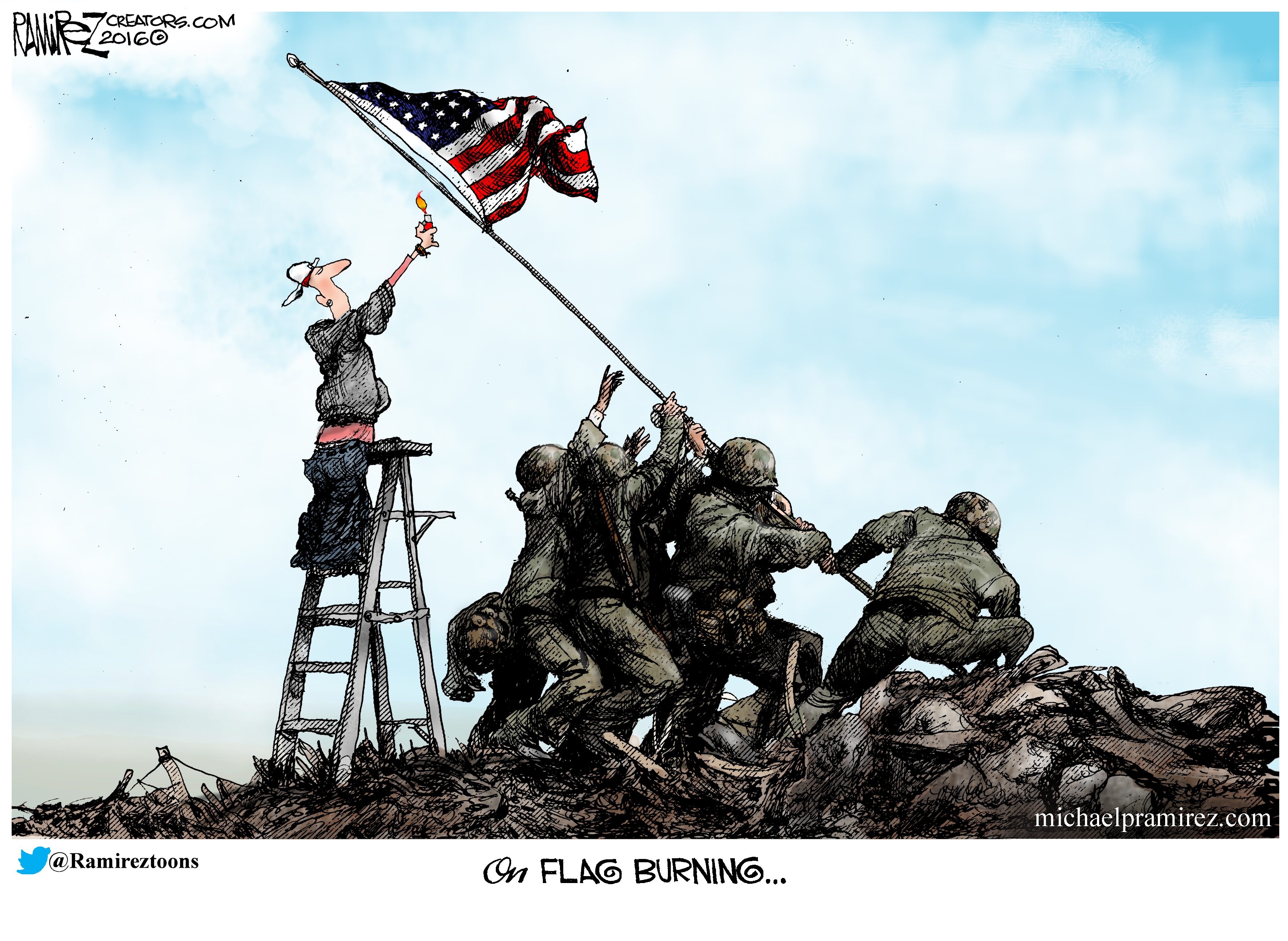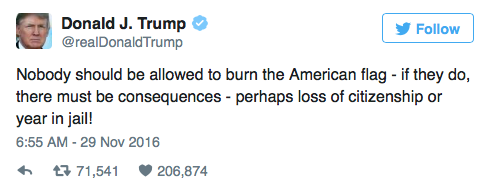Flag burning 11-30-16
MUST THE CONSTITUTION PROTECT FLAG BURNING? [WITH COMMENT BY PAUL] from POWERLINE BLOG POSTED ON NOVEMBER 30, 2016 BY JOHN HINDERAKER
Democrats are burning American flags in violent demonstrations and riots across the country, which led Donald Trump to re-ignite an old debate with a tweet:
Trump’s suggestion that flag burning should not be treated as protected speech was greeted with the usual howls of indignation. The New York Times editorial board contributed a typically ill-informed rant: “Mr. Trump, Meet the Constitution.”
But of course, the Constitution doesn’t mention flag burning. Putting aside the fact that Hillary Clinton once introduced legislation to prohibit flag burning–she was pandering, the Times editorial board says, as though that excused her–the Supreme Court has indeed held that burning the flag is protected political speech, so the legal question is settled for now. But is it settled correctly? Or, put another way, is there anything about the language of the First Amendment or about fundamental First Amendment jurisprudence that requires us to allow flag burning, whether we like it or not? read more below
But of course, the Constitution doesn’t mention flag burning. Putting aside the fact that Hillary Clinton once introduced legislation to prohibit flag burning–she was pandering, the Times editorial board says, as though that excused her–the Supreme Court has indeed held that burning the flag is protected political speech, so the legal question is settled for now. But is it settled correctly? Or, put another way, is there anything about the language of the First Amendment or about fundamental First Amendment jurisprudence that requires us to allow flag burning, whether we like it or not? read more below
Welcome to the Wonderful World of the two-time Pulitzer Prize Winning Political Cartoonist Michael P. Ramirez
I think the answer to that question is No. While the government is not allowed to censor speech based on content, it commonly imposes restrictions as to the time, place and manner in which political and other speech can take place. So, for example, you can stand on a soapbox in the park and shout Communist slogans until you are hoarse. But if you attach a megaphone to a car and drive through residential streets in the middle of the night, waking up residents with amplified Communist drivel, you can be arrested.
Someone who burns an American flag engages in political speech of some kind. He is saying, “I hate America!” Or “America is no good!” Or “I don’t know anything about history!” Or “I am stupid!” Interpretations vary. But whatever he is saying, it potentially falls under the umbrella of the First Amendment. No one questions that the flag burner can get a permit, hang out in a park, and yell “I hate America!” or “I am stupid!” or whatever, without being interfered with. But does that really mean that the flag can’t be protected, as liberals argue?
If a leftist group set out to torture animals in public–cows, horses, dogs–saying that its torture is symbolic, and the message conveyed is “I hate America!” or “I hate American agriculture,” or “we should all be vegetarians,” or whatever, the alleged political motive would not protect the perpetrators against prosecution for animal cruelty. (Or, anyway, it shouldn’t.) The protesters have free speech–they can yammer about GMOs or vegetarianism or whatever to their heart’s content–they just have to leave the cows and horses and dogs out of it.
Similarly, if liberals started publicly torturing small children, claiming that their bloody activity is constitutionally protected because it is a protest against America, just like burning the flag, they would lose. They would go to jail, even though their position would be logical: if you hate America and the American people, what better way to express your opinion than by torturing American children?
All of that being the case, why can’t we protect the flag, under the rubric of “time, place and manner”? You can criticize America all you want, and assert whatever crazy grievances you claim to have. You can scream insults to your heart’s content. One manner in which you can’t express your anti-American opinion, however, is by burning the flag.
What is wrong with that approach? How does it restrict the crazed liberal in any way? He has every right to express his opinion in ways that are far more articulate than setting fire to a flag. But that is one manner (not, of course, the only one) in which he is not permitted to proceed.
I understand why the Supreme Court has held flag burning to be protected speech. The Court’s current position is defensible. But I think the alternative analysis, that the government can ban flag burning without any infringement on the First Amendment rights of anti-Americans, is at least equally defensible, and at least equally consistent with the language of the First Amendment. Under a different Supreme Court, perhaps one with multiple Donald Trump appointees, that view way prevail. I, for one, hope that it does.
PAUL ADDS: I hope it doesn’t. Because of the flag’s powerful symbolism, burning it expresses anti-Americanism with a forcefulness that can’t be matched by words. Flag-burning takes contempt for our country to another level. That, of course, is why we’re so offended by it.
Accordingly, I believe that taking flag-burning off the table as a mode of lawful dissent would meaningfully limit political expression. To do so is unconstitutional, in my view. However, I agree with John that a plausible argument can be constructed to the contrary.
Someone who burns an American flag engages in political speech of some kind. He is saying, “I hate America!” Or “America is no good!” Or “I don’t know anything about history!” Or “I am stupid!” Interpretations vary. But whatever he is saying, it potentially falls under the umbrella of the First Amendment. No one questions that the flag burner can get a permit, hang out in a park, and yell “I hate America!” or “I am stupid!” or whatever, without being interfered with. But does that really mean that the flag can’t be protected, as liberals argue?
If a leftist group set out to torture animals in public–cows, horses, dogs–saying that its torture is symbolic, and the message conveyed is “I hate America!” or “I hate American agriculture,” or “we should all be vegetarians,” or whatever, the alleged political motive would not protect the perpetrators against prosecution for animal cruelty. (Or, anyway, it shouldn’t.) The protesters have free speech–they can yammer about GMOs or vegetarianism or whatever to their heart’s content–they just have to leave the cows and horses and dogs out of it.
Similarly, if liberals started publicly torturing small children, claiming that their bloody activity is constitutionally protected because it is a protest against America, just like burning the flag, they would lose. They would go to jail, even though their position would be logical: if you hate America and the American people, what better way to express your opinion than by torturing American children?
All of that being the case, why can’t we protect the flag, under the rubric of “time, place and manner”? You can criticize America all you want, and assert whatever crazy grievances you claim to have. You can scream insults to your heart’s content. One manner in which you can’t express your anti-American opinion, however, is by burning the flag.
What is wrong with that approach? How does it restrict the crazed liberal in any way? He has every right to express his opinion in ways that are far more articulate than setting fire to a flag. But that is one manner (not, of course, the only one) in which he is not permitted to proceed.
I understand why the Supreme Court has held flag burning to be protected speech. The Court’s current position is defensible. But I think the alternative analysis, that the government can ban flag burning without any infringement on the First Amendment rights of anti-Americans, is at least equally defensible, and at least equally consistent with the language of the First Amendment. Under a different Supreme Court, perhaps one with multiple Donald Trump appointees, that view way prevail. I, for one, hope that it does.
PAUL ADDS: I hope it doesn’t. Because of the flag’s powerful symbolism, burning it expresses anti-Americanism with a forcefulness that can’t be matched by words. Flag-burning takes contempt for our country to another level. That, of course, is why we’re so offended by it.
Accordingly, I believe that taking flag-burning off the table as a mode of lawful dissent would meaningfully limit political expression. To do so is unconstitutional, in my view. However, I agree with John that a plausible argument can be constructed to the contrary.
Younger Americans Are Less Patriotic. At Least, in Some Ways.
Lynn Vavreck @vavreck JULY 4, 2014 New York Times
|
Americans are a patriotic bunch. Compared with people in most other countries, Americans express more pride in their nationality, and most say that being an American is an important part of their identity.
Even so, patriotism in America is on the decline. But the decline seems to have more to do with reactions to the symbols of American democracy than its values. Older Americans remain remarkably high in their devotion to symbols like the flag, while young citizens are cooler toward Old Glory but express higher support for classic American ideals like equality and opportunity. The patterns suggest the shifts are generational and not driven by stages in the life cycle. Past generations have declined only marginally in their nationalism over time – they start out high and mainly remain so. But today’s youngest generation begins adulthood with much lower levels of fondness for the symbols of America, and if the past is a guide, there is no reason to expect increases as they age. Measures of American patriotism over the last several decades are found in the American National Election Study (A.N.E.S.), the nation’s longest-running data collection on political attitudes and behavior. Started in 1948, the A.N.E.S. is funded by the National Science Foundation, and the interviews are done in person every four years, in the homes of nearly 2,000 randomly selected Americans. When you see the American flag flying, the A.N.E.S. asks, how good does it make you feel? People can choose from categories that range from “extremely good” to “not good at all.” In 2012, 79 percent of Americans responded with extremely or very good. Only 7 percent said slightly or not good at all. read more at New York Times |
|




